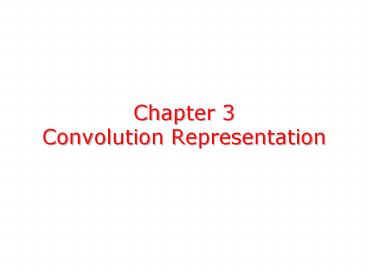Chapter 3 Convolution Representation - PowerPoint PPT Presentation
Title:
Chapter 3 Convolution Representation
Description:
Chapter 3 Convolution Representation DT Unit-Impulse Response Consider the DT SISO system: If the input signal is and the system has no energy at ... – PowerPoint PPT presentation
Number of Views:95
Avg rating:3.0/5.0
Title: Chapter 3 Convolution Representation
1
Chapter 3Convolution Representation
2
DT Unit-Impulse Response
- Consider the DT SISO system
- If the input signal is and the
system has no energy at , the output
is called the
impulse response of the system
System
System
3
Example
- Consider the DT system described by
- Its impulse response can be found to be
4
Representing Signals in Terms ofShifted and
Scaled Impulses
- Let xn be an arbitrary input signal to a DT LTI
system - Suppose that for
- This signal can be represented as
5
Exploiting Time-Invariance and Linearity
6
The Convolution Sum
- This particular summation is called the
convolution sum - Equation is called
the convolution representation of the system - Remark a DT LTI system is completely described
by its impulse response hn
7
Block Diagram Representation of DT LTI Systems
- Since the impulse response hn provides the
complete description of a DT LTI system, we write
8
The Convolution Sum for Noncausal Signals
- Suppose that we have two signals xn and vn
that are not zero for negative times (noncausal
signals) - Then, their convolution is expressed by the
two-sided series
9
Example Convolution of Two Rectangular Pulses
- Suppose that both xn and vn are equal to the
rectangular pulse pn (causal signal) depicted
below
10
The Folded Pulse
- The signal is equal to the pulse pi
folded about the vertical axis
11
Sliding over
12
Sliding over - Contd
13
Plot of
14
Properties of the Convolution Sum
- Associativity
- Commutativity
- Distributivity w.r.t. addition
15
Properties of the Convolution Sum - Contd
- Shift property define
- Convolution with the unit impulse
- Convolution with the shifted unit impulse
then
16
Example Computing Convolution with Matlab
- Consider the DT LTI system
- impulse response
- input signal
17
Example Computing Convolution with Matlab
Contd
18
Example Computing Convolution with Matlab
Contd
- Suppose we want to compute yn for
- Matlab code
n040 xsin(0.2n) hsin(0.5n) yconv(x,h) s
tem(n,y(1length(n)))
19
Example Computing Convolution with Matlab
Contd
20
CT Unit-Impulse Response
- Consider the CT SISO system
- If the input signal is and
the system has no energy at , the output
is called the
impulse response of the system
System
21
Exploiting Time-Invariance
- Let xn be an arbitrary input signal with
for - Using the sifting property of , we may
write - Exploiting time-invariance, it is
System
22
Exploiting Time-Invariance
23
Exploiting Linearity
- Exploiting linearity, it is
- If the integrand does not
contain an impulse located at , the
lower limit of the integral can be taken to be
0,i.e.,
24
The Convolution Integral
- This particular integration is called the
convolution integral - Equation is called
the convolution representation of the system - Remark a CT LTI system is completely described
by its impulse response h(t)
25
Block Diagram Representation of CT LTI Systems
- Since the impulse response h(t) provides the
complete description of a CT LTI system, we write
26
Example Analytical Computation of the
Convolution Integral
- Suppose that where
p(t) is the rectangular pulse depicted in figure
27
Example Contd
- In order to compute the convolution integral
- we have to consider four cases
28
Example Contd
- Case 1
29
Example Contd
- Case 2
30
Example Contd
- Case 3
31
Example Contd
- Case 4
32
Example Contd
33
Properties of the Convolution Integral
- Associativity
- Commutativity
- Distributivity w.r.t. addition
34
Properties of the Convolution Integral - Contd
- Shift property define
- Convolution with the unit impulse
- Convolution with the shifted unit impulse
then
35
Properties of the Convolution Integral - Contd
- Derivative property if the signal x(t) is
differentiable, then it is - If both x(t) and v(t) are differentiable, then it
is also
36
Properties of the Convolution Integral - Contd
- Integration property define
then
37
Representation of a CT LTI System in Terms of the
Unit-Step Response
- Let g(t) be the response of a system with impulse
response h(t) when with no initial energy
at time , i.e., - Therefore, it is
38
Representation of a CT LTI System in Terms of the
Unit-Step Response Contd
- Differentiating both sides
- Recalling that
- it is
and
or































